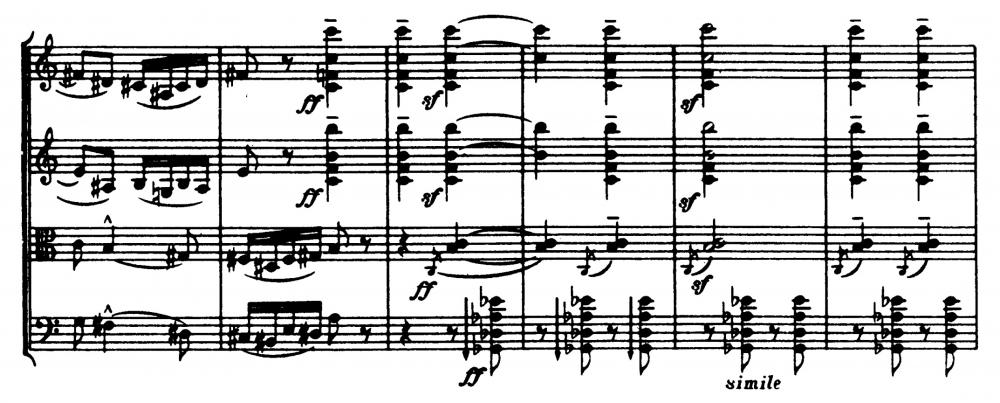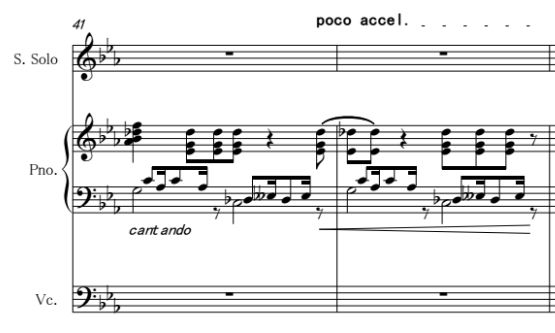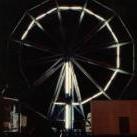Leaderboard
Popular Content
Showing content with the highest reputation on 08/05/2016 in all areas
-
I composed this piece about a year ago. It wasn't for any specific piece of media, but I composed it with an action scene in mind. It was created using Logic, EW/QL SO, and NI's Komplete 9. Let me know what you think!1 point
-
I recently worked at a kid's instrumental music camp and was thankfully commissioned to write a few pieces for the students involved (string orchestra, chamber). Is it weird that I found myself more initially paralyzed to write music for them then I would for a professional orchestra? I've always had problems coming up with initial melodies, so that affects me for writing for both professional players and beginner players. But in terms of finishing the piece with interesting parts for all the instruments that is engaging for them to play (i.e. what they'd find "cool" music to play), I find myself having to rewrite and ponder things more. Does anyone else have this problem?1 point
-
I agree, I also find it more difficult to write good "easy" compositions more appropriate for a student level ensemble or performer rather than writing unfettered by considerations of difficulty. I wrote a set of six piano pieces initially setting out to write them at an intermediate level but after working on a few of them I abandoned that limitation as it was hard for me to write pieces that I thought were both easy but also not overly trite.1 point
-
Yeah, that's right, last movement of the 4th. It's not that what you say is untrue and one should certainly not pen difficult quadruple stops lightly, but it is dangerous to teach people to be afraid of instruments and write in an overly simple manner in my opinion. It's one thing to abstain from impossible trombone glissandos that require faking and makes everyone annoyed, but it's completely another to abstain from writing quadruple stops that are just very uncomfortable. A lot of players like the challenge; plus the uneven intonation and rough articulation are an effect unto themselves which to some extent happens by itself and is more difficult to emulate in well-behaved writing.1 point
-
Is this the 4th quartet? Could be wrong, but I remember watching it and thinking that it couldn't be Bartok... the violin quadruple stop in the violins is insane (especially with the transition), but not impossible. And fair enough, but keeping open strings involved is a good rule of thumb I teach people starting out in composition. As they learn the instrument more, they can branch out a bit, but that's because they realize that fifths or sixths in your triple or quadruple stop generally makes things easier for them in first position. (<---- OP, that's the relevant takeaway from this post, haha.)1 point
-
I guess nobody told Bartók, although there are a lot of things Bartók was not told… Anyway, I think it is misleading to say that open strings must be involved. Not only is that "rule" patently ignored in many seminal string works, especially of the last century, but there are many "closed" quadruple stops that are very doable. I am only familiar with viola fingerings but I have tried a cello and while it is certainly much more difficult there is nothing about the spacing which makes it impossible, plus in the higher positions that point becomes somewhat moot. Not that these quadruple stops are in any way easy to tune… EDIT: Regarding the Bartók, I realize it is just a simple finger barre in this particular example, but that's besides the point, this is just something that instantly sprung to mind.1 point
-
1 point
-
1 point
-
1. The higher up on the cello you go, the less string you have for it to vibrate. A minor third on F can only be played starting with the F one position before thumb position, which is already about 1/2 way up the cello. It's not so much an awkward shift as it is one that requires the whole string of notes before it to be up there as well. 2. No. Like I said, chords that utilize an open string normally work better. But more importantly, the chords need to be spaced out correctly. The cello has the open strings of C (on the bottom), G, D, and A, all a fifth apart from each other. You need to think about how far apart a players fingers will need to be playing the chord. 3. Octaves in the cello are generally considered a very showy, soloistic thing to have in a piece. These specific octaves are very hard to play because they are so low on the cello. Additionally, the right hand of the piano plays the same notes, so you'd might as well just have the left hand play them in octaves as well, and have the cello play one line, or not play altogether. 4. Cellos playing thirds without an open string is generally hard to play twice in a row because you have to shift two fingers at the same time instead of just one. It makes it hard on the player for not that much gain. 5. Then beam them differently. You need to beam two eighth notes together properly so that the emphasis is on the off-beat. A string player won't be able to tremolo that fast, either, so reduce the amount of split lines on it as well.1 point
-
That's a lot of work! I'll give you one. Dance of the Flowers from the Nutcracker. @ 54:30 I especially love the dancing. George Balanchine was brilliant.1 point
-
There have always been a much greater amount of bad music being currently written than good music, because write good music is hard, and write bad music is easy, it's not matter of this current present only, but all presents in the past, what happens is that time works as a filter, and only good music survives, and bad music is forgotten, that's why it looks like in the old times was written only good music, because the old trash has dissapeard, and now is trash all over the place, but don't worry, time will clean it, and bad music will be forgotten, and good music, beyond our personal opinions, will survive even if someone tries hard to distroy it. What I'm trying to say is that we do have our Bachs and Beethovens right now writing their masterpieces, but recognize them in the middle of the current jungle, is always a very hard task, besides is not up to us to pick them who's yes who's no, time will do it. Sometimes looks like time makes mistakes, but no, even if something good is being drawn in centuries, if it's really good it will come to surface like Vivaldi. We musn't forget our classics were all contemporary at their times, writing the most complex and difficult music of their days, No one said "I am writing classical music", they all were pushing the current style into the next step, No one is remembered today for writing "old style" music. One example to finish my post: An Old lady was listening to Bach in the church, He was playing "Sleepers Wake", as you may know the theme of this isn't Bach but a older hymn, the lady kinda recognized the theme along with the other line Bach added, she went to search the priest and accused Bach to be destroying the hymn, that he would not being allowed to do such things, that the other lines added were not even according to the theme (the Lady's critic on Bach counterpoint) that modern styles must be forbidden, it was a sin, it had too many notes were not even capable to listen or pay attention to all, etc etc all kind of negative "musical" critics. There were tons of organist, composers, back then, non of them were making those "modern" stuff, only Bach, and only Bach is remembered, the others are dead, and the lady ? made an historical ridiculous mistake.1 point
-
Okay so I interpret m. 0-13 to be the tonal introduction, while everything else is purposefully atonal: m. 0-36: Cellos are not written in alto clef; bass clef or tenor clef is definitely preferred. m. 1: The triple stop in the cello is ridiculous. I don't know if you intended for all three notes to be played at once, but that's not possible. You're going to want to put a roll marking in there so they know to separate the root from the rest of the chord. m. 2: Juxtaposing a G7 against a Cm triad is a little weird. m. 5: A harmonic G on that note is a little bit difficult. You're also going to need to notate if it's an octave up or not. If it is, they need to jump from a normal position to an obscure one just to play that note. If it's not, they'll need to shift to at least 4th position to play it. m. 7: Cello has Cm, soprano has G7, and piano has D˚... it clashes too much in my opinion. m. 8-9, 12: Gm and G triads clash too much. --------------------------------------------------------- m. 15: F and A-flat double stop requires thumb position, which doesn't sound very good in pizzicato that high. Also, an awkward shift to get up there. m. 16: Again, you need a roll or something in the cello. This chord requires a random jump to 6th or 7th position, so maybe take the root out from the bottom and highlight it in the other voices. m. 26, 32: Pretty high note for a soprano... m. 33-34: Octaves in the cello are hard and not very useful. The Cm chord needs to be split again. m. 37-38: Some pianist find grace notes to the same chord to be annoying, but not all do. m. 38: Cello: having the grace notes with the rolled chord is impossible; you'll need to decide which tones you actually need. m. 45: Having the harmonic on the B-flat is going to be hard to hit, keeping it straight would be much simpler, since they would already be in position. m. 49-50: The rhythm writing for the cello is off. Keep things in terms of 4/4, people are going to get confused. m. 54-55, 56: You can probably have one of how ever many double stops in that measure. Both is going to sound bad. m. 58: You're looking for tenor clef, not alto clef. m. 60: Same advice about the rolls or split chords for the cello. m. 67-68: Are you not going to beam the soprano 16th to the dotted? I only ask because you do it in the other voices. m. 67-69: Dot slurring 4 notes will make some cellists uncomfortable; two might be easier. m. 70: Cello: Same advice. m. 73: I would pick two notes to play in the cello instead of 4. m. 75, 78, 79-80, 82, 85, 87, 89: Same advice about triple stops for cello. m. 101-106: Those notes are so short, you'd be fine just having one slash through them... they won't be able to play tremolo. m. 106-107: Combine all the eighth notes into a couple half notes with the same notation. ------------------------------------------------------------------------------- Generally: Beaming is done to keep the beats in line with each other... like in 4/4 the beaming of the notes is generally going to want to make it look like it's in 4/4, not as if it's 8/8 where the rhythm is variable. If it IS as variable as it is in your piece currently, I'd suggest 8/8, 6/8, etc. in some of your sections. Cello triple stops are generally bad unless they can be easily rolled; quadruple stops are only okay if there are open strings involved. To counteract the triple stop thing, you can go into the second layer and put the bottom note as a "shorter" note than the top two notes, so it becomes a double stop, or put a roll marking in there. Triple stop triads are generally very hard to play and a string player will assume you're not very used to writing music for them. Also, cellos use tenor clef, not alto clef, which is alto clef shifted up one line. Your chords in your atonal section (or how I heard it) generally resolve themselves pretty well, so there's just technical things to tend to now. Good luck!1 point
-
Hi The melody (voice) is very interesting, with unsual intervals (5+). The range is a bit demanding for an average soprano (Bb2 - C5: more than two octaves). In the first part there are difficult parts because the tesitura is high. The second part is more balanced (I think). Your harmonic language here is also interesting. What I'm not sure at all is hoy you use the cello. Usually it's not an instrument to play "background chords" (measure 78 and 70, for example). Besides, I guess some of this triple stops are, if not impossible, very difficult. This double and triple stops are reserved to talented soloist for the cello. Perhaps, It would be difficult to find a "normal" cellist who could play this. I also think your work would benefit of some structure (parts and sections, with repetition and variation). I recognise some phrases that are repeated. I like there are parts where the voice is still, it's a good contrast.1 point
-
This blows my mind, because you know there are people that are still writing serial and serial inspired pieces to this day, right? That's like saying you don't see muscle cars coming back. Because of course, the heyday of the muscle car is gone. And yeah, the mainstream of automotive output isn't muscle cars. But the design concepts introduced by the muscle car era are still influencing todays designs, and there are still cars being produced that can be considered muscle cars. Serialism doesn't have to come back, it never went away. it has been fully integrated into the modern composer's array of tools available to him, and it is a fool that ignores it as a fad just as much as it is a fool that ignores tonality.1 point






